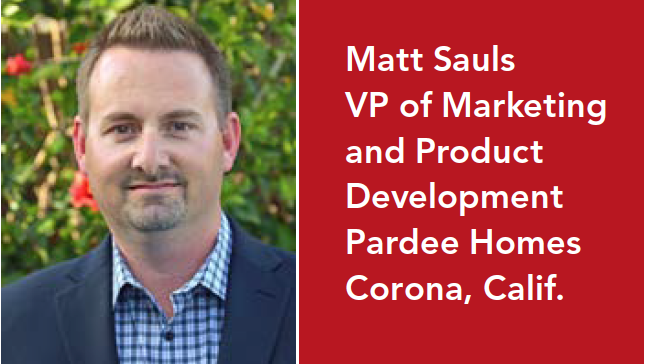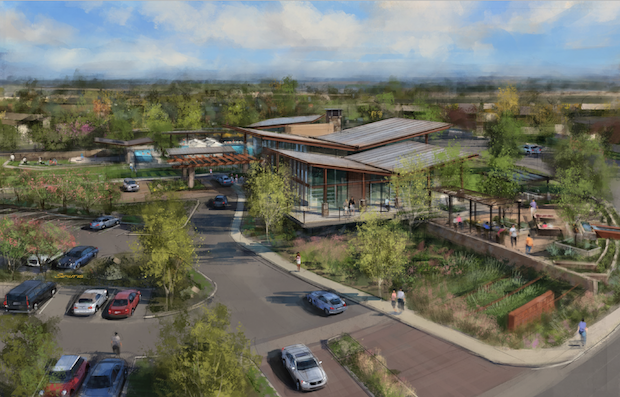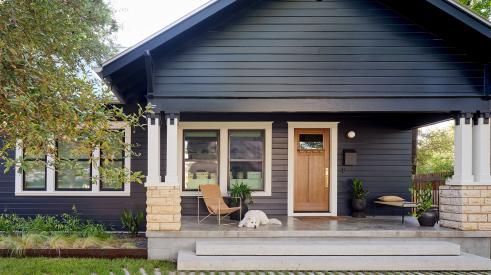
After numerous visits to active adult communities and research into Baby Boomer preferences, TRI Pointe Group last year launched the Life360 platform to guide its six home building operations as they enter the 55-plus market. Life360’s four pillars—vitality, adventure, connectivity, and style—aim to ensure that designs and amenities appeal to the younger Boomer buyer.
Each regional builder will use Life360 as a starting point, in addition to delivering their own local flair for location selection, branding, activities, and design. Matt Sauls handles product development for the company's Inland Division -- Pardee has operations in Pasadena, Corona, and San Diego, Calif., and Las Vegas. Altis, in Beaumont, Calif., is Pardee’s first 55-plus development and one of the six communities that TRI Pointe companies are building for this market. Altis held its grand opening in early November 2018 and upon completion will comprise 704 homes priced from the low $300s to the mid-$400s.
Q: In your research, what did you find was typical about Southern California’s 55-plus communities, and how will Altis be a departure from that?
A: As we set out to decide whether we wanted to do a community like this, we were aware of the big players everyone’s familiar with, which have done it so well for many years. So those were the first places we went to.
We also did a complete brand analysis and visited just about everybody else that’s doing 55-plus. We broke them down into the developers/builders doing large-scale communities, where their whole focus is on active adults, like Del Webb and Shea Homes’ Trilogy, and the other groups from the builder space—and we’re probably no different—that build all-age communities. So you see William Lyon Homes, Taylor Woodrow, Toll Brothers, and, as you go across the country, you’ll see lots of builders have stepped in, but not in the way Del Web and Trilogy have. It’s more like, let’s dip our toe in the water and create a brand.
What I would say is different about us is we’re owned by the TRI Pointe Group, which approached home building in a completely different way when it acquired the Weyerhaeuser Real Estate Company [in 2014]. TRI Pointe kept the brands of the companies it acquired, unlike other builders that acquire a company and that company just melts into the fabric of the acquiring entity and the brand goes away.
So when we went through the brand exercise for active adult, there were two ways to look at it: Does TRI Pointe want to create a national brand? Or does TRI Pointe believe that—just as there is power with the local home building groups—there is power in local operating teams and a local brand awareness? Does it make more sense to create communities with consistent brand pillars across the entire TRI Pointe company but allow individual neighborhoods to take on the character of what’s special about that particular location?
Our answer was that our communities are local, therefore they’re going to be curated, based on what’s special about the site, the surrounding area, and the buyer profile in that area because not everybody in this category is exactly the same.
We’re going to take those brand pillars, which are unifying forces, and add that special local sauce. The differentiation we saw, even with the top players, is that you often see the same floor plans, no matter where you go. The buildings and amenities are executed roughly the same, whatever the site’s location. They’re operating with a lot of data and on a national platform of understanding consumer preferences. We’re trying to be more boutique and curated.
Q: What were the other elements of brand research involved?
A: Deborah Blake, founder of [55-plus consulting firm] The Ipsum Group, was part of our team from the first. Our initial step was to have a master plan in Beaumont, which is planned for 4,500 homes. We’re now about 2,500 to 3,000 homes into that neighborhood.
As we worked with Tri Pointe Group to see if there was an opportunity to build something there for this demographic, we did demand studies and hired John Burns Real Estate Consulting and RCLCO Real Estate Advisors [Robert Charles Lesser & Co.] to weigh in.
We are absorbing 250 units of demand in our all ages communities and we kind of topped out for that submarket. So we asked if there is additional demand? The research came back and said yes there is probably an additional 150 to 200 units of additional demand specifically for this life stage. From there we hired BDX to do a national 55+ consumer preference survey. Tri Point Group wanted to take the research national with the ability to cross tab down into local markets like Southern California and submarkets.
We used that preference study to drive a lot of things that people were interested in from amenities, home design, and what their financial concerns were on HOAs, tax rates, and the total cost of ownership. That process is how we came up with our brand pillars. What we saw through the research is there was a lot of sameness in these communities, and the consumers that are coming into this age cohort are people who are still working; they like to have fun; they really are active and because of that we wanted to become the younger, fresher, hipper version of this type of community design.
Q: What did Pardee learn concerning the features and amenities that buyers want at Altis?
A: If you go to a Del Webb or a Shea Trilogy community today, often they are not building their amenity buildings until two or three years after they open for sales. Putting amenities at the very front end of the community is very cost intensive. TRI Point was very direct. They said because we are the new players to the space, we need to build our amenities up front. So they made a huge capital investment, and we grand opened Altis with our amenities completely done. That was our commitment to lifestyles first. What we heard from the data is that your lifestyle and what you create is the most important thing even before the homes.
We are not the biggest 55+ community, but we are large. Some of the new players in this space are designing communities with 150 to 250 homes. This is a large-scale community so research showed we needed to be gated. We have provisions for security at the front and budgeted for that and the homeowners’ association. We have an internal paseo system that will total almost 2 acres of paseos that wind through the community and loop back to the center of the community where our recreation center that we call the VuePoint. It was set in place at the heart of the community to take advantage of the beautiful views of the San Bernardino Mountains.
We did a design competition around the design of the overall community and the architecture for that building. With Deborah's help and our internal team, we narrowed it down to three groups and we did a design competition: We told them they had to pair with a landscape architect, an architect, and a general contractor because sometimes these wonderful designers create something that is too expensive to build. We ultimately selected SHJ Studio from Phoenix, which paired with Anderson Baron landscape design.
They created a design that was very modern, very upscale, and pretty unique to the Inland Empire. We're on the edge of the desert although we are still part of the Inland Empire. So we knew we would appeal to people who really cared about high design and were also looking at Palm Springs, Palm Desert, or La Quinta so when you look in our amenities and our home design you will see a harkening back to Mid-Century designs and things that have really existed in our area before.
It started with this idea that Altis is the center of the universe, meaning we are close to so many things and have great programming onsite. Just this week I am hiring a lifestyle director and that full-time lifestyle director's response ability will be to inject programming not only on site but—and we think this is what is going to separate us the others who are doing this—we have so many wonderful things 30 to 45 minutes from where we live. So the person we are hiring is going to be providing almost like concierge level service to help connect people outside of the community as well.
What we found in the research is these are not retirees like people think of in days past where they just sit around on site and play bridge. There are people who still want to do that but these are people who are biking, hiking. They want to go to see concerts. They want to have fun, and we're hiring a team to make sure we foster that.
You'll see a huge impetus from us on lifelong learning. You'll see a huge emphasis on food and wellness. We found that drink, food, and healthy activity is such a huge social activity with this demographic. You'll see friendships forming around the hiking club, the walking club, the bartenders club. They want to connect.
One major criticism we saw from lots of different consumers as we talked about other places is that the amenities shut down at 6 o'clock. There are no events in the evening, and half of our population will still be working. So our goal is to make this a place where there are things to do for people no matter what stage of life they are in. We will have things early morning for people who are retired and things in the evening for the road warriors who just got home and want to have a place to go to dinner and watch the game.
Q: How does Altis figure in the competitive landscape for the Inland Empire’s 55+ market in the Inland Empire?
A: Terramor—a master planned community in Corona being developed by Foremost Companies—is in the $400s to $500s. They have hillside view premium-driven place. Ours on a base-to-base price is going to be cheaper, which makes sense because they are closer in to the coast than we are, which is why we think our programming has to be so good.
If you're going to move from the coast or farther west out of the Inland Empire, you have to have a reason to go a little bit farther. I think our prices will allow homebuyers have a great lifestyle at a lower total cost of ownership. I also think that our community is very walkable, which is extremely important to this consumer. Our community design is geared towards arteries that lead you back into Vuepoint at the center of the community. It will so be very easy for somebody to take a walk to the club. At other places you'll probably have to get into golf cart or a car to do that.
Q: What inning do you think the home building industry is in with this current business cycle?
A: In all ages buying, which is the consumer that buys usually because of a life change, maybe they just had more kids or they’re trying to move to a new school district, I think in that cycle, we are in the late innings. We are seeing a little more resales on the market and interest rates are affecting the price-sensitive buyer. In the Inland Empire, we are usually a heavily an FHA-driven buyer so it is having an effect on that.
However, I think the 55+ buyer is in a different place. If you look back historically even through cyclical downturns, 55+ has weathered that better than other times. Many of them will be paying cash. They have reserves. They're just in a better financial position because of where they are in their life stage. All that coupled with the wave of people coming from that age group, it may slow but it will be healthier compared with what we may see late innings.
Also, the cost and expertise to do these types of communities is not an easy hurdle for the builder community. So a lot of builders are not going to want to come into this space and therefore we will not see as many competitors. That means not as much product being built and not as many communities competing with each other. It is a very different consumer and you can get it very wrong by just thinking that you were going to build the homes the same way for them you are for the all ages are. Active adults are looking for different things.
Advertisement
Related Stories
Sales + Marketing
Q+A With Jenny Laible: The Keys to a Community Lifestyle Program
The National Association of Home Builders' 2024 Lifestyle Director of the Year talks about authenticity, knowing your neighbors, and her chill approach to social media
Construction
Q+A With Jenny Kerr Schroen and Chris Eccleston: Grit Leads to Greatness
The co-authors of Grit Leads to Greatness are finding their book's message resonates deeply with students, school administrators, and parents alike
Q+A
A Builder Discusses Product Strategy
Which products make a difference? Andrew Houlihan of Houlihan Building Company dives into what kinds of products matter to builders and their clients, including the Marvin Elevate® and Essential™ Collections








